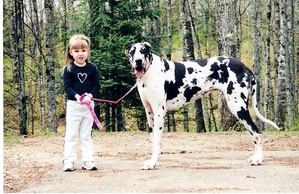Truly great, as much in majesty as in size, the Great Dane is one of the largest dog’s in existence. A gentle giant, the Great Dane possesses a friendly and playful disposition. It’s an ancient breed, with similar-type dogs appearing in frescoes and other artwork from Greece and Egypt dating to more than 5,000 years ago! A 5th Century Danish coin depicts a large hunting dog believe to be a Great Dane.
The most striking feature of the Great Dane is their massive size. Minimum standards dictate that male Danes are not less than 30 inches tall – 32 inches and above is preferable (females can be slightly smaller, standing only 28 inches or more). Their weight ranges from 100 pounds for females to 120 pounds for males – while the AKC no longer states a minimum weight, those are generally accepted standards, however, the tall dogs should appear well muscled and proportionate to its great height.
Their large size makes Great Danes easily identified, and their presence will draw attention from everyone in the immediate vicinity. The largest living dogs are usually Danes – currently the Guinness Book of World’s Records recognizes a black Great Dane named Zeus ...

